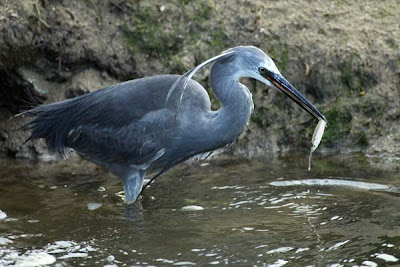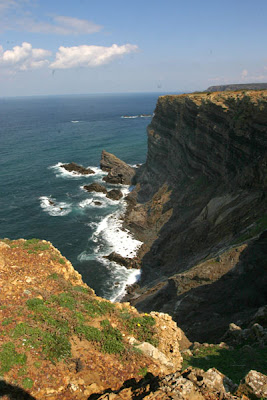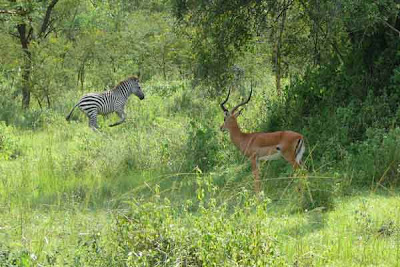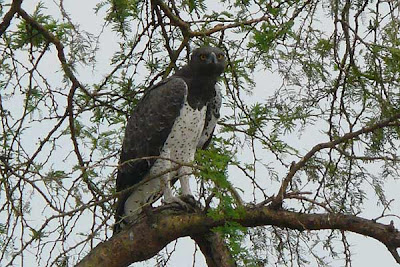Our early start meant that by 10.30am we had arrived at our first stop, Bigodi, located just outside Kibale National Park. Bigodi is a community-based project that provides access to Magombe Swamp, an interesting area of papyrus and swamp forest. It gives local people jobs and revenue, at the same time protecting the area and its wildlife. Without doubt the star bird here was a very confiding Shining Blue Kingfisher but others seen included Black Cuckoo, Olive Thrush and Red-breasted Ant-Thrush. Kibale Forest is one of the best in East Africa for primates so Red Colobus and Grey-cheeked Mangabey were no surprise but L'Hoest’s Monkey is a species I’ve only in the past seen at Bwindi.

We spent much of the afternoon watching Chimpanzees in the forest. On this occasion it didn’t take too long to find them - they can be quite noisy creatures! We spotted two adult males that were harassing a youngster but it wasn’t long before they settled down with a group of eight other males and then just sat around peacefully grooming each other. The arrival of a female with a small baby caused some brief excitement amongst the group but peace quickly returned and the grooming continued. As a finale to the day we stopped for some birding along the road to the lodge, finding Cassin’s Grey Flycatchers at a regular spot and a Blue-throated Roller.
Much of the next day was spent travelling but there were stops for birding once we had gone through the bustling town of Fort Portal. Along the edge of the forest there was lots of activity and Yellowbill, Yellow-crested Woodpecker, Yellow-whiskered Greenbul, Fire-crested Alethe, Buff-throated and Black-capped Apalises were soon added to our growing list. We stopped for lunch in Hoima a town that seems likely to change before long following the discovery of oil in the area. Then we continued to our hotel in Masindi, again for just a one-night stay. After checking in, we quickly headed for a nearby wooded area where birds seen included Lesser Blue-eared Starling, White Helmet-shrike, Lizard Buzzard, White-winged Black Tit and Striped Kingfisher.
The following morning we left after an early breakfast for Budongo Forest, and the famous 'Royal Mile' which promises some of the best forest birding in Uganda. Shortly after meeting with our local guide, Vincent, we were seeing birds as more than a dozen Black-and-white-casqued Hornbills flew in attracted by swarms of flying ants that were emerging from the nearby fields. Very soon four White-thighed Hornbills also arrived. A wonderful morning’s birding followed as we saw many difficult to see species including four species of kingfisher - African Dwarf, African Pygmy, Blue-breasted and Chocolate-backed. Another star species today was African Crowned Eagle – a pair in display flight above us and later one perched close to the trail.
After lunch we re-traced our steps and tried for a second time to see Blue-shouldered Robin-Chat as not all group had seen one earlier. We finally left the forest at 1.30pm after stopping to watch two Chocolate-backed Kingfishers squabbling over a huge insect.
As we travelled north towards the River Nile the landscape was changing and becoming drier; on the escarpment, where we saw Foxy Cisticola and Chestnut-crowned Sparrow-Weaver, the vegetation was very poor and scrubby. When we eventually arrived at the river, Intermediate Egret, African Darter, African Fish-Eagle and Nile Crocodile were all noted as we waited for the ferry which would take us across to Paraa Lodge.
Next morning we met with Captain Nelson and headed off in his boat for ‘the delta’, the area where the Victoria Nile enters Lake Albert. This stretch of the Nile is one of the most reliable places to see a Shoebill and although we had seen one earlier at Mabamba I was determined that we should have a better look at one. The birding along the river was great with lots of egrets, herons, kingfishers and African Darters to see along with Hippos, Elephants and Crocodiles but we were on a mission and had a long way to go so stops were rare. Eventually our target was sighted - a lone Shoebill standing motionless not too far from the river. Captain Nelson manoeuvred his boat into the bank so that we could all get better looks and photographs of this most bizarre-looking bird. It moved little as we watched and was obviously not worried at all by our presence.
After a while we moved on leaving the Shoebill to its lungfish hunting but soon it was time to turn around and head back up river. When we did the Shoebill was nowhere to be seen as we passed the place where we had so recently seen it. We had been very lucky!! The return trip was a bit more relaxed and we were able to enjoy the birds and animals with great views of African Darter, Goliath Heron, Northern Carmine and Blue-breasted Bee-eaters, Elephants, Waterbuck, Hippos and some very big Nile Crocodiles.
After an excellent lunch we headed out into the park for a game drive with George, a local ranger, who had been in the park earlier in the day and had seen Lions. Once again the birding was excellent with huge flocks of hirundines wheeling around catching flying insects. Tawny Eagle, Abyssinian Ground-hornbills, Isabelline and Woodchat Shrikes, Grasshopper Buzzards in various plumages, Piapiacs and Red-billed Oxpeckers were all noted along with Elephants, Buffalo, Oribi, Giraffe and Patas Monkey. Then a big cat was spotted running alongside the bus and it ran across the track in front of us chasing a Kob. It was a Leopard and we watched as it disappeared into the long grass. A little further on a Lion was lying alongside the track. It had obviously recently fed as it took no notice of us and seemed hardly able to stay awake. The light was now fading and a few drops of rain began to fall but as we headed back towards the lodge another lion was spotted, this one more alert and on the lookout for its supper. As darkness fell Square-tailed Nightjar and Spotted Eagle Owl were heard.
Our last day was to be mostly taken up by the long drive to Entebbe but before we left the Nile behind we had to visit Murchison Falls. We crossed the Nile on the 7.00am ferry and drove to the top of the falls where as well as enjoying the spectacle of cascading water we were able to see a couple of Rock Pratincoles, two Giant Kingfishers and a Wahlberg's Eagle. During a short walk along the road we also saw several Red-winged Grey Warblers and two African Cuckoo-Hawks.
The rest of the journey was uneventful and we arrived at the Botanical Beach Hotel with plenty of time for a shower and a cool beer before Fred and Robert took us to the airport for our homeward flights.
So that was Uganda! It’s probably my favourite of all the tours I lead for Avian Adventures and I can see Peter and me disagreeing when it comes to deciding which of us goes there next time!











































